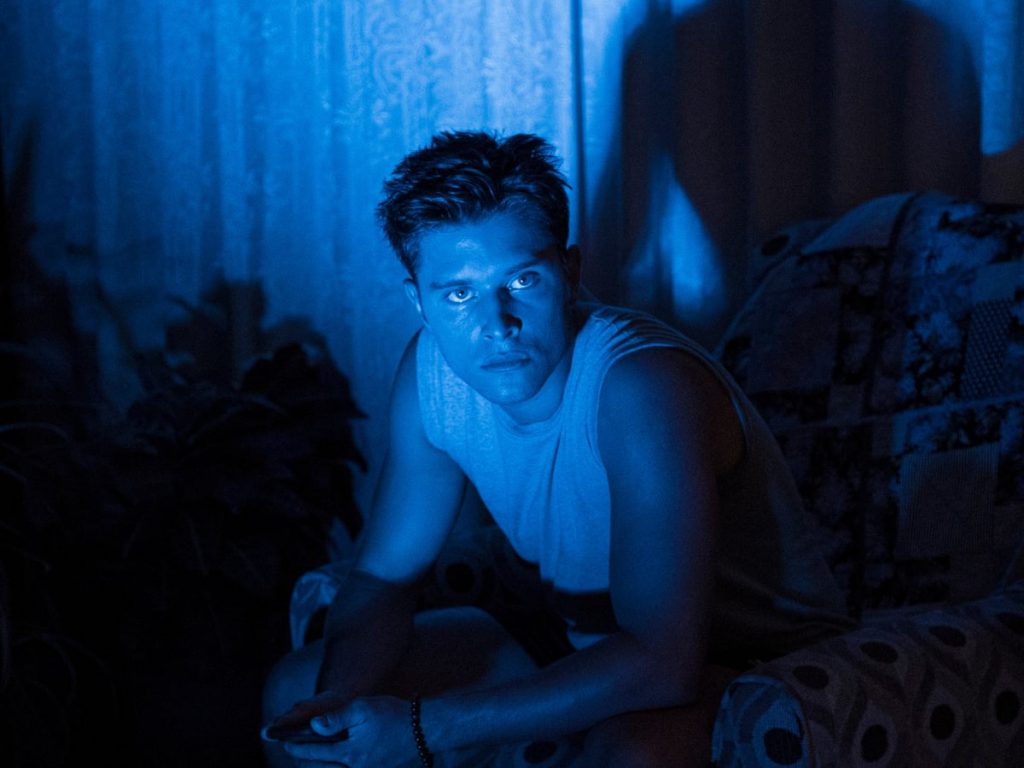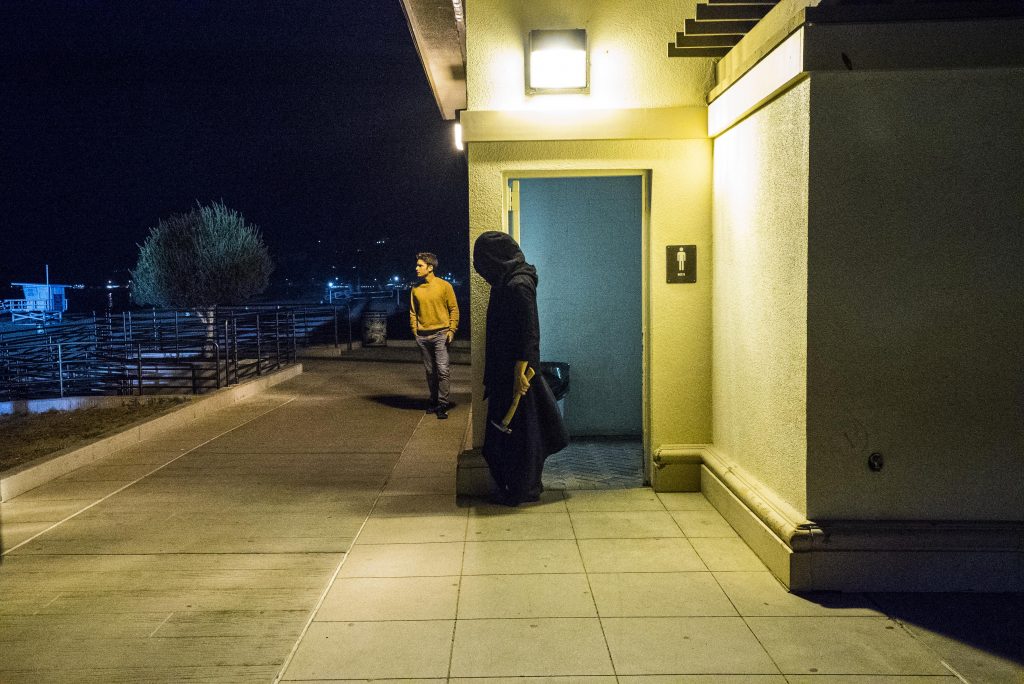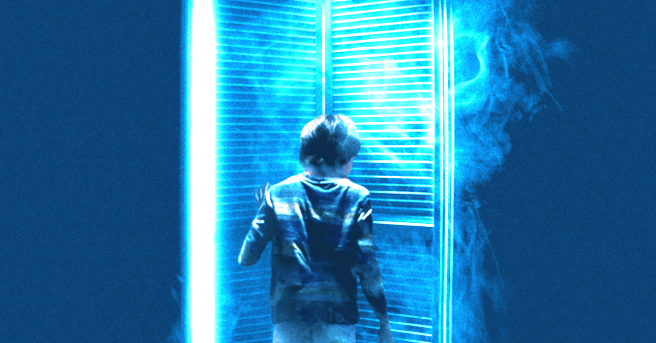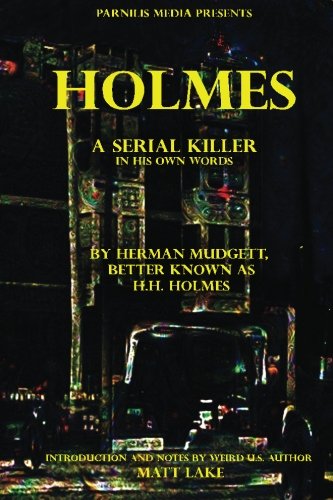
‘Smiley Face Killers’ review: A film not worth anyone’s time
I hate trashing movies. I really do. Even some of the worst films in existance are redeemable in some way, but Smiley Face Killers is a film made for no one. I’m an easy-going girl. I don’t fret about time wasted or ill-spent because why bother? There’s always tomorrow right, well this damn movie had me bitter about the hour and thirty minutes I wasted watching it. Time I could’ve spent on rewatching Re-Animator. Every now and then I will come across a film that not only baffles me but makes me wonder why the hell they even made the thing?
What is this film? Other than an excuse to ogle over Ronen Rubinstein’s body and to offer an undercooked crime theory, there’s almost no point to its existence. It’s not entertaining, it’s not informative, it’s not moving, it’s not anything. It’s just there. The excessive amount of boob shots that appear in the Friday the 13th remake has nothing on this attempt at a psychological slasher. Smiley Face Killers could be a drinking game, there are over 15 full shots of actor Ronen Rubinstein’s naked chest and a little over 10 shots of his naked ass. The lights in his shower are brighter than the ones in his bedroom. Honestly, the way this movie constantly finds a way to take off Rubinstein’s clothes is the best thing about it because it’s so hilarious.
Rubinstein is indeed a sight to behold but I prefer my objectification with a bit of little plot to go with it. Otherwise, he’s just a lifeless pretty face, like a corpse, a corpse that acts about as bored as I was while I was watching this. May I suggest 9-1-1: Lone Star or Some Kind of Hate if you want to see a more decent showcase of Rubinstein’s face and acting. Don’t go here.

Directed by Tim Hunter and written by novelist Bret Easton Ellis whose strength clearly resides in books and not screenplays, Smiley Face Killers is a big dull dud that doesn’t know what to do with itself. It’s also a complete waste of potential. If the last 20 minutes were separated from the rest of the feature and made into a short film, it would’ve been pretty good. The rest is just excess and such a pointless endeavor that it’s astounding. Did they have some extra money lying around and decide to just poop out a film over the weekend?
The story follows young college student Jake Graham (Rubinstein) as he’s being stalked by three hooded figures who plan on murdering him. Even though he’s somewhat aware of their presence, he doesn’t exactly realize what’s going on yet he can feel their eyes watching and it’s putting a major damper on his social life.
Before we’re even introduced to Jake though, the film offers up an explanation for what’s about to happen. The explanation appears like a written prologue on the screen less than five minutes into the opening explaining that it is based on a true story. “Since 1997, more than 156 young men across US college campuses have drowned under suspicious circumstances. Symbols spray-painted at the scenes have led some to propose these accidents are in fact, serial killers.” This basically just gives everything way and is a sign of the film’s laziness. It prefers to just tell the audience what is happening rather than show it through a story.
What follows is treated as one segment in a long series of events that have already happened. Such a setup makes the film feel like a slasher posing as a documentary made with the quality of a Lifetime movie.

Jake himself is not a very likable protagonist. Almost immediately we’re told about his unspecified mental illness for which he requires medication that he’s recently stopped taking. We’ve seen this before, haven’t we? A poor protagonist is not taken seriously because they are “crazy” and off their meds. Same thing here.
However, we see nothing of Jake’s behavior before the film so his friends and girlfriend constantly bringing up his lack of meds and apparent strange behavior just sounds like white noise. It doesn’t help that Jake himself acts no different between the start of the film and the end of the film. By the way, another thing about Jake…he never brings up the fact that someone is actively following him around for about 99% of the movie. The stalkers aren’t even trying to be inconspicuous. They leave their van in the open, kill Jake’s roommate, chase him down the street, start sending him strange texts, and even break into his room to leave clues of his demise, but he never makes the connection that these actions are the workings of someone dangerous. He never considers calling the police.
Crispin Glover plays the lead killer who has only a minor appearance. The only performance, outside of a brief burst of life from Rubinstein near the end, with any actual weight behind it. He’s joined with two others and together they form a cult that seemingly worships a figure known as Galiel who shares a connection to water.
What their religion is and who they worship is never explained but it’s the reason they’re drowning young men across America for each sacrifice is meant to represent Galiel in human form being sent back to the ocean. All this is crammed into the last 20 minutes when it should have been the premise itself.

What is the real smiley face killers theory?
The backbone of Smiley Face Killers is the alleged true story that it’s based on. It’s the reason the plot goes nowhere as Hunter and Ellis worry too much about going along with these events within their own story that they want to match in menace and mystery. The premise of the film is loosely based on a serial killer theory that’s been floating around in urban legend status for years. The theory largely comes from three individuals, two retired detectives and a professor, who believe that a number of young men who have drowned in various bodies of water across Midwestern America from the late 1990s to the 2010s are actually the victims of a serial killer or a group of killers.
The “smiley face” part comes from the occasional smiley face graffiti mark found near some of the bodies. Many of which were later discovered to have been painted on years before the victims lived in the areas.
The theory hasn’t been well received by experts and isn’t supported by any evidence aside from the few smiley faces (one of the most popular graffiti markings of the 1990s) found at the scenes. Many of the deceased died after consuming large amounts of alcohol and drugs and showed no signs of trauma prior to entering the water. The “research” for this film clearly consisted of just googling “smiley face killers theory” and copying the alleged torture and murder of Christopher Jenkins, one of the victims whose parents claimed he was tortured in a van for hours before getting dumped in the water despite there being no indication that this is true. Jenkins’ body showed no signs of trauma and contrary to popular belief, water does not magically wash away all evidence. Though it does make homicide considerably harder to prove.
‘The FBI has reviewed the information about the victims provided by two retired police detectives, who have dubbed these incidents the “Smiley Face Murders,” and interviewed an individual who provided information to the detectives. To date, we have not developed any evidence to support links between these tragic deaths or any evidence substantiating the theory that these deaths are the work of a serial killer or killers. The vast majority of these instances appear to be alcohol-related drownings. The FBI will continue to work with the local police in the affected areas to provide support as requested.”
FBI National Press Office, FBI Statement Regarding Midwest River Deaths on April 29, 2008

Verdict
Again I will ask, what the hell is this movie? Who made the okay for this? Cats was a better horror movie than this. Mr. Ellis if you’re listening, stick to writing books! This whole thing was a poorly researched take on a seemingly true story about as solid as cheesecloth. The characters were less than one-dimensional but just descriptions of characters reading lines like they were half-asleep.
Smiley Face Killers deserves one star for attempt but the appearance of Crispin Glover and the whole final act brings it up to one and a half. Way to go.
 (1.5 / 5)
(1.5 / 5)
Movies n TV
Wheel of Time A Question of Crimson Is a Political Espionage Delight
Episode two of Wheel of Time felt like the beginning of a long journey. Stories are unfolding, lives are changing, and blood is spilling.
Let’s discuss.
The story
We begin this episode in the past with Elayne’s mother, Queen Morgase. It turns out her rise to the throne was a bit, shall we say, cutthroat. So when she shows up at the White Tower, Siuan is concerned.
She might have reason to be, too.
Meanwhile, Rand, Egwene, Moiraine, Lan and Aviendha are in the Spine of The World. As they travel through some of the most breathtaking lands I have ever seen on a TV show, Egwene is plagued with nightmares. We think at first that’s just her trauma working itself through her system. But we soon find out that it might not be that straightforward.
Finally, Perrin returns home to heal after his hand is almost cut in half. But when he gets there he finds the town has been infested by Children of The Light. And they’re looking for him.
What worked
There was something heartwarming in this episode about political espionage and choking religious persecution. And that is Elayne’s relationship with her family.
I have consumed a lot of fantasy content with royal families. And I have never once heard a princess call her mother ‘Mum’. I’ve never seen royal siblings get along. And I have sure as hell never seen a princess have a good relationship with her step-parent.
This was refreshing. Even though Queen Morgase is kind of a horrible person she seems like a good mother. And that’s an unexpected delight.

Of course, this is just one storyline among many. And while this can sometimes be overwhelming, in this case it wasn’t.
I’ll be honest, some of these storylines are going to drag for me. I know this because I’ve read some of the Wheel of Time books and I have an idea that not all the characters exactly pique my interest.
No one likes all the characters. No one likes all the storylines. While I am here for the political espionage between Queen Morgase and Siuan, not everyone likes it. While others might be fascinated with Selene trying to win Rand back, I couldn’t care less.
Having multiple storylines keeps everyone’s attention better. So long as things don’t get out of hand. Things can easily get out of hand. But this seems to be managed well.
So far.
What didn’t work
As I mentioned above, I’m not thrilled with Rand’s story at this point. And while it’s fine to not like a storyline when there are this many to choose from, it’s not fantastic that the one I like the least is the one involving our two main characters. And anytime we were with the team at the Spine of The World, the only thing that brought me joy was Moirain’s hat. It reminded me of Stockard Channing’s hat in Practical Magic.
The problem is that Rand is Charlie Brown with controversial magical powers. He is boring, serious, and pessimistic.
And yes, I understand that he has a heavy emotional burden and he’s the Dragon Reborn and that’s quite taxing and all. But let’s be fair, there isn’t a single person in this show that doesn’t have a heavy burden. And most of them manage to be fun occasionally.

All that being said, this episode of Wheel of Time did exactly what it needed to do. It set up conflicts at each of the three locations. It established emotional ties between the characters and the events. And it established goals for everyone.
This was, in short, a solid episode. Not groundbreaking, not mind-blowing or life changing. It was simply good. It was entertaining and moved the plot forward.
Well done.
 (3.5 / 5)
(3.5 / 5)
Movies n TV
Wheel of Time Returns With A Bang
Wheel of Time is back for season three. There are mixed feelings regarding this. Last season, there were some serious pacing issues. And some serious sticking to the book’s storyline issues. But we’re two seasons in, and we don’t give up so easily. So let’s dive into episode one, To Race the Shadow.
By the way, I highly recommend watching this episode with the subtitles on. You’ll see why.
The story
We begin this episode with Liandrin facing a trial of sorts for her rampant betrayal. She does her best to gaslight her Aes Sedai sisters into thinking that Siuan Sanche is the real traitor.

When that doesn’t work, she reveals how many Black Aes Sedai have actually infiltrated the tower.
Spoiler, it’s a lot.
In the aftermath, our whole team gathers to drink and enjoy one night of relaxation before they head out to the Tear to form an army for Rand. All is going well until they’re attacked by myriad creatures and a sentient axe.
What worked
This episode was long. It had a run time of an hour and eleven minutes. And a lot of that run time was spent in heavy dialog scenes.
Fortunately, these were well-done scenes.
If you’re going to have a lot of talking scenes, there are good ways and bad ways to do it. Last season, we saw lots of examples of the bad way to do it. But this episode did it well. For one thing, other things were going on while conversations were taking place. The characters are drinking, playing games, walking through an interesting city. And the scenes themselves didn’t stretch out. They weren’t repetitive. We heard what the character had to say, then we moved on.
It was also nice that the point of these scenes wasn’t just info dumps. We had character development. We had romantic interactions. We had plot development and foreshadowing.
Overall, this episode felt like what it was. A moment of calm before a storm.
Taking a step back, I’d be remiss if I didn’t address the fight scene at the start of the episode. Because it was epic.
The magic looked amazing. The martial arts that went along with it looked fantastic. The costumes were beautiful. It was just incredibly fun to watch.
More than that, it was emotional. We lost some characters in that fight that were important. And it was clearly emotionally shattering for many of our characters, who found themselves betrayed by people they trusted.
So many of them.
It was a great way to open the season.
What didn’t work
Despite that, this episode wasn’t without its flaws.
First off, there were a lot of dialog scenes. And they were good scenes, as I’ve already discussed. But it was one after another after another. And when your episode is, again, an hour and eleven minutes, it’s maybe a little much to have so much chit-chat. Couldn’t some of these conversations, important as they were, have been moved to maybe another episode?
Finally, I want to talk about Egwene’s travel through the arches.

I feel like maybe there were some deleted scenes here. Because there must have been more to that visit than what we saw, right?
We could have seen Egwene battle Rand. That would have been badass and emotionally devastating. We could have seen her with a quiet life with Rand back home at the Two Rivers. We could have seen anything except for the quick clip of Rand in a bloody river, followed by Egwene being shoved back out in a bloody shift.
Bad job. But at least it wasn’t an extended scene of Moiraine collecting bathwater, and then taking a bath while looking sad. If we’d started this season with another scene like that, it might have broken my brain.
Amazon dropped the first three episodes at once. So we’ll be back soon to talk about episode two. See you then.
 (4 / 5)
(4 / 5)
Movies n TV
Entertaining as hell: Eight Legged Freaks (2002) Review
Early 2000s is a special era for the industry. It accepts the cheesiness and corniness of movie making, in turn producing some gems in their own right. Eight Legged Freaks starring David Arquette and young Scarlet Johanson is a horror comedy about giant spiders who overtake a small town. As crazy as that premise sounds, the movie surprisingly has a ton of heart and is super entertaining. Let’s review, shall we?
Plot
We start Eight Legged Freaks with a shot of toxic waste spilling into the water supply of Joshua, a spider farm owner. He is friends with Mike, one of our protagonists, who is a science geek and a spider enthusiast. Mike notices something quite right upon visiting Joshua, but no one takes him seriously. We are then introduced to the rest of the crew. Mike’s mother Samantha, the town sheriff, is too busy chasing Ashley, his sister, who is dating the town mayor’s son Bret (something Samantha does not approve of). We also have Chris, who returns to the town to save his father’s legacy in the town mines. He has opposition from Wade, Bret’s father, who wants to use the mines for his business ventures. Lots of drama going on that will only get juicier once the spiders get loose.
The creepy crawlies quickly dispose of Joshua and make their grand appearance after Ashley rejects Bret’s advances, abandoning him in the middle of a desert. A glorious chase sequence ensues as the spiders make their way towards the town, wreaking havoc on its residents. In a true horror fashion (which the movie acknowledges), it takes some convincing from Mike and then from Samantha for the town to take the threat seriously. The tongue-in-cheek style of narrative adds the comedy aspect to a movie that would otherwise burn out fairly quickly.
The remaining characters hide out in a shopping mall as it’s the only somewhat sturdy building in the area. This doesn’t last long as the spiders break in, forcing them to run through the mines. Their resources to fight the creepy crawlies off are limited as the methane gas doesn’t allow them to use firearms. Such conditions require resourceful thinking from Chris, who uses perfume to fend off the leader of the spider group and save himself during the climax of the movie.
Character dynamics are not forgotten once the action kicks in. We have Chris confessing his long-term feelings for Samantha which she knew all along, which provided some comedic relief. Bret also reunites with Ashley and apologises for being an asshole. Mike finally gets the appreciation he deserves as his knowledge saves the townsfolk more than once during the whole ordeal.
We end the movie with the town’s radio show person telling the story as an urban legend during his segment. This brings it into question – how much of it happened the way he said it did? We can only guess…
Overall thoughts
Eight Legged Freaks is a fun creature feature with some self-aware commentary on genre tropes that doesn’t take itself too seriously. The acting is good, the pacing fitting and the characters are likeable enough for you to want them to make it through. Definitely a must watch, if you don’t suffer from arachnophobia, that is.
 (5 / 5)
(5 / 5)








